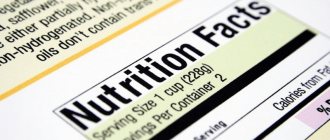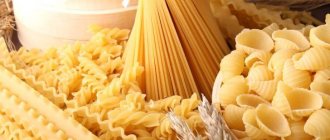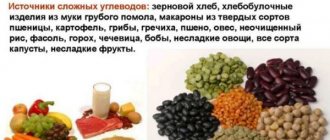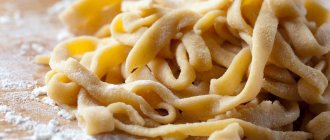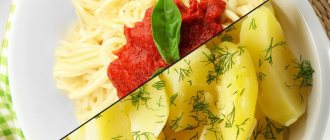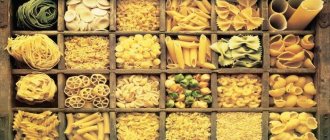General rules
Carbohydrates are the main source of energy in the body, but they are different and do not have the same effect on metabolism.
- Monosaccharides (simple) are quickly broken down into glucose and fructose and are very quickly absorbed, providing calories and energy. If calories are not burned throughout the day, they will eventually be converted into fat stores. These include products made from refined premium flour, honey, jam, sugar, cookies, sweet pastries, and sweet fruits.
- Polysaccharides (complex) take much longer to break down and absorb. The body receives energy evenly, and a person does not feel hungry for a long time. Products containing these carbohydrates have a significantly lower glycemic index. These are products containing fiber and pectin: whole grain bread, cereals, pasta made from whole grain flour and durum wheat flour, whole grains, brown rice, vegetables, fruits.
To successfully lose weight, your diet must contain complex carbohydrates. By including them in your diet and at the same time limiting fat, you can reduce your daily calorie intake, because a gram of fat carries 2 times more calories. Fiber from cereals is low in calories and provides long-lasting satiety, while the body receives the vitamins and minerals contained in cereals. This is what the pasta diet for weight loss is based on. This method of losing weight is preferred by those who cannot give up bread, cereals and pasta.
The question immediately arises, is it possible to eat pasta on a diet? If so, which ones can you eat? Pasta made from soft wheat flour is not suitable for dietary nutrition. The starch it contains is a fast carbohydrate and is easily digestible. Refined flour is practically devoid of vitamins , minerals, and fiber. This is a source of empty calories and there will be no benefit from such a dish. Additionally, they have a high glycemic index , especially if overcooked (60-69).
Eating such dishes in combination with fatty types of sauces leads to rapid weight gain. Instant pasta products, for example, “Rolton”, “Big Lunch”, “Doshirak” and others are also made from premium wheat flour, which is poor in micronutrients. Such pasta is not the best choice for people leading a healthy lifestyle and especially should not be used during a diet. The composition states vegetable oil (soybean or sunflower), but may also contain hydrogenated fats, which are truly harmful to the body.
The main harm of fast food products in food additives: preservatives, dyes, flavor enhancers, acidity regulators, stabilizers and thickeners. All of these ingredients are legal, so there is no reason to think that they are dangerous, but they are not healthy either. An abundance of salt and hot spices has an adverse effect on weight loss - water is retained, appetite is stimulated, and there is a risk of increased blood pressure and digestive diseases. Flavor enhancers ( monosodium glutamate ) make you want to eat more, and acidity regulators irritate the gastric mucosa.
Despite the fact that, compared to other samples, the composition of “Rolton” is the most natural (the labeling indicates the absence of preservatives, phosphates, dyes, nothing is said about acidity regulators and antioxidants), nutritionists still do not recommend using this pasta constantly in your diet . It also produces spaghetti from durum wheat, but recently (2014) expert opinions have appeared indicating that the product contains a significant admixture of soft wheat flour.
Dietary pasta is a product made from durum wheat (grano duro), which contains mainly complex carbohydrates. Such pasta contains more gluten, significantly more vitamins B , A , E , amino acids, micro- and macroelements and healthy fiber. The latter regulates the feeling of satiety, as a result of which a person eats less, and also stimulates the function of the gastrointestinal tract, preventing the occurrence of constipation .
Plant fiber is not digestible, but plays the role of a sorbent for cholesterol , toxins and metabolic . These pasta products contain a sufficient amount of protein (10.45 g) to maintain muscle mass during weight loss and practically no fat (1.3 g). The packaging of these pasta products must bear the inscription “Group A”.
Although their calorie content in dry form is quite high (330-344 kcal), when cooked, the weight increases 2.5 times, as a result, the “output” of a 100 g serving of ready-made pasta we have on average is 137 kcal. At the same time, they do not lose nutrients. The glycemic index of cooked products is 49-50, and slightly undercooked pasta is 20% lower (40) - this also needs to be taken into account.
From this we can conclude that pasta will not harm your figure, subject to moderate and reasonable consumption. The calorie content will increase significantly by adding oil and various fatty sauces to this dish. For dietary nutrition, you can use rye, whole grain, high in dietary fiber, buckwheat pasta.
The most acceptable and balanced diet is a diet that includes four to five meals a day with one consumption of pasta.
Basic diet rules
- Choose the right type of product.
- For one meal - a portion of 50-100 g of dry products.
- Do not overcook - they must remain solid, otherwise you will end up with a product with a high glycemic index, which is not acceptable for use in a weight loss program.
- It is better to eat pasta, like any carbohydrate foods, in the first half of the day: include a small portion in one of your meals for breakfast or lunch. In this case, the calories received will be used up during the day.
- Vegetables or a protein dish should make up your evening meal.
- Boiling or baking all other dishes - with a minimum amount of fat.
- Olive oil 1 tbsp. spoon a day.
- Including vegetables (salads) twice a day.
- Avoiding fatty sauces and appetite-stimulating seasonings.
- Drinking regimen: 1.5-2 liters of liquid, including unsweetened tea, herbal teas and water.
- Duration of at least a week and up to a month if there is no weight gain.
- Physical activity is required.
- Gradual reduction in caloric intake.
The big advantage of this diet is its compatibility with other products. Harmonious additions to pasta dishes include vegetables, seafood, mushrooms, herbs, garlic and olive oil. Pasta dressings can be low-calorie sauces that include sweet peppers, tomatoes, a small amount of garlic, tarragon (ginger, basil) and salt. Separately, you can prepare mushroom sauce with onions and a minimum of olive oil.
A separate meal can be cereals, fish with vegetables, juices (grapefruit and orange), toast from grain bread, low-fat cheese, cottage cheese. As with any other diet, the diet should not contain sugar, sweets, pastries and other sweets.
The second diet option involves eating 300 g of spaghetti during the day, divided into several meals. By consuming this amount of pasta you will get 960-1000 kcal without taking into account other dishes. The daily calorie content should be 1200-1300 kcal, if you are not actively involved in sports, so other dishes account for 400-300 kcal. It is designed for a month, during which it is expected to reduce weight to 5 kg.
From our point of view, eating pasta alone is unlikely to be beneficial, since the proportion of animal proteins will be small. So, only 100 g of boiled beef will already add 254 kcal. Approximately the same amount of calories will be contained in 100 g of mackerel, trout or salmon and 300 g of boiled hake, pollock or cod. It turns out that vegetables, cottage cheese, fruits, and fermented milk drinks will already exceed the daily caloric intake.
First, let's figure out what gluten is.
Gluten (or gluten) is a protein found in grains of cereal plants, primarily wheat, rye, and barley. Healthy people digest gluten normally.
Gluten intolerance should not be confused with the serious disease celiac disease. If the first occurs in 40% of Russians, the second is diagnosed in only 1% of the population. Intolerance is accompanied by disturbances in the gastrointestinal tract, a feeling of fatigue, and excess weight. In people with celiac disease, gluten causes an immune reaction in the small intestine, damaging its walls and leading to inflammation.
Remember that such diagnoses should only be made by a gastroenterologist.
Authorized Products
- Vegetables, except starchy ones (zucchini, potatoes, beets, corn, pumpkin, radish, squash, Jerusalem artichoke). Preference is given to cucumbers, tomatoes, lettuce, greens, spinach, white cabbage, eggplant, broccoli, sweet peppers, celery greens, all types of onions, beet leaves, chard, tops of edible plants, green peas, Chinese cabbage.
- Lean meat (no more than 1-2 times a week) and fish, which should prevail in the diet over meat dishes.
- Any type of seafood, boiled or grilled.
- Low-fat fermented milk products, cottage cheese, low-fat cheeses in limited quantities (50-70 g per day).
- Unsweetened varieties of fruits and berries, juices from them.
- Whole grain bread in the amount of 1-2 pieces is allowed, but its use is usually not necessary.
- Whole grain porridge (buckwheat, barley, pearl barley, millet, oatmeal) and unpolished rice - once a day or every other day.
Table of permitted products
| Proteins, g | Fats, g | Carbohydrates, g | Calories, kcal | |
Vegetables and greens | ||||
| greenery | 2,6 | 0,4 | 5,2 | 36 |
| eggplant | 1,2 | 0,1 | 4,5 | 24 |
| cabbage | 1,8 | 0,1 | 4,7 | 27 |
| broccoli | 3,0 | 0,4 | 5,2 | 28 |
| chard | 1,8 | 0,2 | 3,7 | 19 |
| olives | 2,2 | 10,5 | 5,1 | 166 |
| carrot | 1,3 | 0,1 | 6,9 | 32 |
| cucumbers | 0,8 | 0,1 | 2,8 | 15 |
| beet tops | 2,1 | 0,5 | 5,5 | 17 |
| celery | 0,9 | 0,1 | 2,1 | 12 |
| asparagus | 1,9 | 0,1 | 3,1 | 20 |
| tomatoes | 0,6 | 0,2 | 4,2 | 20 |
| green beans | 2,8 | 0,4 | 8,4 | 47 |
| green beans | 2,0 | 0,2 | 3,6 | 24 |
| lentils | 24,0 | 1,5 | 42,7 | 284 |
| spinach | 2,9 | 0,3 | 2,0 | 22 |
Fruits | ||||
| oranges | 0,9 | 0,2 | 8,1 | 36 |
| grapefruit | 0,7 | 0,2 | 6,5 | 29 |
| apples | 0,4 | 0,4 | 9,8 | 47 |
Berries | ||||
| berries | 0,7 | 0,3 | 9,4 | 44 |
Mushrooms | ||||
| mushrooms | 3,5 | 2,0 | 2,5 | 30 |
Cereals and porridges | ||||
| oat groats | 12,3 | 6,1 | 59,5 | 342 |
| millet cereal | 11,5 | 3,3 | 69,3 | 348 |
| brown rice | 7,4 | 1,8 | 72,9 | 337 |
| brown rice | 6,3 | 4,4 | 65,1 | 331 |
Flour and pasta | ||||
| premium pasta | 10,4 | 1,1 | 69,7 | 337 |
| spaghetti | 10,4 | 1,1 | 71,5 | 344 |
| spaghettini | 11,2 | 1,6 | 68,4 | 333 |
| tagliatelle | 21,7 | 2,2 | 63,3 | 374 |
Bakery products | ||||
| whole grain bread | 10,1 | 2,3 | 57,1 | 295 |
Raw materials and seasonings | ||||
| dried greens | 3,0 | 0,0 | 24,5 | 210 |
Cheeses and cottage cheese | ||||
| cottage cheese | 17,2 | 5,0 | 1,8 | 121 |
Meat products | ||||
| veal | 19,7 | 1,2 | 0,0 | 90 |
Bird | ||||
| boiled chicken breast | 29,8 | 1,8 | 0,5 | 137 |
| turkey | 19,2 | 0,7 | 0,0 | 84 |
| * data is per 100 g of product | ||||
What kind of pasta can you eat every day and not gain weight - Om Activ
Following the principles of a healthy diet, pasta is not only possible, but also necessary to include in the diet, the main thing is to know what kind. Therefore, we found out from Sergei Gladkov how to choose the right dietary and healthy pasta on the shelves of Moldovan stores.
What is real pasta?
In fact, pasta is any product made from flour, made for subsequent cooking, including even dumplings and dumplings. By the way, products that are boiled immediately after cooking, such as ravioli, are called fresh pasta. And what we used to call pasta is dry pasta, products that are first dried and only then boiled. A healthy and dietary paste is a product made from semolina, the inner part of the durum wheat grain.
Do they produce real pasta in Moldova?
No, because the local climate is not favorable for growing durum wheat. In principle, this is possible, but it is not grown in Moldova. So, if you see a “made in Moldova” mark on the packaging of pasta, you should know that this product is not a dietary product, it can make you gain weight.
What is the difference between durum wheat and regular wheat?
Flour made from durum wheat contains less starch and gluten and more protein than flour from soft wheat.
Moreover, products made from durum wheat are more tasty. But the biggest advantage of pasta made from durum wheat is that it does not get soft or stick together when cooked.
On the shelves you can also find products made from whole grain durum wheat - they have a little more gluten and fiber, but a little less protein.
By the way, rich pastries are prepared, unfortunately, only from soft varieties of wheat, which makes them quite high in calories and absolutely not dietary.
Why should durum pasta be included in the diet?
Firstly, real pasta is rich in plant fiber. Fiber itself is not digestible, but it perfectly absorbs and removes waste substances, heavy metal salts and toxins from the body, and improves the functioning of the digestive system as a whole.
Secondly, the paste contains vitamin E, a beauty vitamin that prevents the appearance of wrinkles and other signs of skin aging. It also contains B vitamins, which are responsible for healthy skin and hair.
Thirdly, the paste contains tryptophan, which improves mood, helps normalize sleep, and is also necessary for the production of serotonin, the hormone of joy.
By including pasta in your diet, you will increase the body's resistance to stress, eliminate insomnia, and forget about headaches, including migraines. Regular consumption of durum wheat products helps strengthen the heart muscle, bones, and normalizes the level of hemoglobin in the blood. By the way, this product is completely safe for diabetics because its glycemic index is quite low.
How many times a week can you eat real pasta without harming your figure?
Pasta made from durum wheat not only does not harm your figure, but also helps you lose weight. It consists of complex carbohydrates that keep you feeling full for a long time. Pasta made from soft wheat varieties, in turn, consists of simple carbohydrates - they contribute to a surge of insulin in the blood, which causes a feeling of hunger.
The fat content in pasta is minimal. And their calorie content is only 270-360 kcal per 100 grams of dry product, which after cooking must be divided into two.
Artyom Tkachev,
nutritionist, author of the “Remote weight loss” course, founder of the service for developing an individual diet and delivering healthy food “Eat&Fit”
Pasta is not such a terrible thing as many people think, the main thing is that it is made from durum wheat, then it is a good source of slow carbohydrates. Yes, they contain more starch than, say, buckwheat, but not at all as much as, for example, potatoes. Glycemic index is around 40.
You can eat them at least every day, in accordance with the energy needs of the body, although such nutrition can hardly be called varied. But it is preferable to eat them, of course, in the first half of the day or until the early evening.
What should you pay attention to when choosing pasta in the store?
The packaging of a quality paste should be transparent or have a transparent window through which the buyer can evaluate the appearance of the product.
Ideal products should be translucent, pure, amber-yellow in color, without whitish inclusions or cracks. If there are cracks/chips, the pasta is most likely not of high quality.
The packaging of a top quality product must indicate that it is made from durum wheat and belongs to group A.
A very important indicator is the amount of protein indicated on the label. In good durum products, the protein content should range from 7 to 9 grams per 80 grams of pasta (average portion for 1 person).
In the bad ones, the protein content in 80 grams of the product is no more than 6 grams. The higher the protein content, the better the pasta.
Real pasta consists of only two ingredients - flour and water. The presence of natural dyes is acceptable (green - spinach, red - tomato).
In some countries, Italy and Turkey among them, pasta is legally allowed to be produced only from durum wheat. So feel free to choose products made in these countries.
Save
(6573)
comments powered by HyperComments
Fully or partially limited products
- Pasta made from refined flour.
- Fatty dairy products.
- Chocolate, candy, sugar, halva, jam, dried fruits, honey, waffles, cookies, pastries, condensed milk, gingerbread, crackers, white bread, cakes.
- Animal fats, fatty meats, lard, bacon.
- Sugary carbonated drinks and sweet fruit juices. Preference should be given to vegetable ones.
- Sweet fruits (persimmon, grapes).
- Avoid starchy vegetables.
Table of prohibited products
| Proteins, g | Fats, g | Carbohydrates, g | Calories, kcal | |
Vegetables and greens | ||||
| fried potato | 2,8 | 9,5 | 23,4 | 192 |
Fruits | ||||
| figs | 0,7 | 0,2 | 13,7 | 49 |
| persimmon | 0,5 | 0,3 | 15,3 | 66 |
Berries | ||||
| grape | 0,6 | 0,2 | 16,8 | 65 |
Nuts and dried fruits | ||||
| raisin | 2,9 | 0,6 | 66,0 | 264 |
| dates | 2,5 | 0,5 | 69,2 | 274 |
Flour and pasta | ||||
| pancakes | 6,1 | 12,3 | 26,0 | 233 |
Bakery products | ||||
| buns | 7,2 | 6,2 | 51,0 | 317 |
| wheat bread | 8,1 | 1,0 | 48,8 | 242 |
Confectionery | ||||
| jam | 0,3 | 0,2 | 63,0 | 263 |
| jam | 0,3 | 0,1 | 56,0 | 238 |
| candies | 4,3 | 19,8 | 67,5 | 453 |
| cake | 3,8 | 22,6 | 47,0 | 397 |
| jam | 0,4 | 0,2 | 58,6 | 233 |
| halva | 11,6 | 29,7 | 54,0 | 523 |
Cakes | ||||
| cake | 4,4 | 23,4 | 45,2 | 407 |
Chocolate | ||||
| chocolate | 5,4 | 35,3 | 56,5 | 544 |
Raw materials and seasonings | ||||
| mayonnaise | 2,4 | 67,0 | 3,9 | 627 |
| honey | 0,8 | 0,0 | 81,5 | 329 |
| sugar | 0,0 | 0,0 | 99,7 | 398 |
Dairy | ||||
| cream | 2,8 | 20,0 | 3,7 | 205 |
Meat products | ||||
| fatty pork | 11,4 | 49,3 | 0,0 | 489 |
| salo | 2,4 | 89,0 | 0,0 | 797 |
| bacon | 23,0 | 45,0 | 0,0 | 500 |
Sausages | ||||
| smoked sausage | 28,2 | 27,5 | 0,0 | 360 |
Fish and seafood | ||||
| fried fish | 19,5 | 11,7 | 6,2 | 206 |
Alcoholic drinks | ||||
| white dessert wine 16% | 0,5 | 0,0 | 16,0 | 153 |
| vodka | 0,0 | 0,0 | 0,1 | 235 |
| beer | 0,3 | 0,0 | 4,6 | 42 |
| * data is per 100 g of product | ||||
Menu (Power Mode)
The menu is free and you can create it according to your preferences. Menu example:
- Breakfast: tea or coffee without sugar, cottage cheese with fruit or a boiled egg with whole grain toast.
- Lunch: any pasta or spaghetti dishes with vegetables, mushrooms, seafood, lentils, soup with vegetables and pasta, vegetable salads for pasta.
- Afternoon snack: baked apple or fresh fruit, fruit and vegetable juice, fruit salad with yogurt, berry mousse, kefir.
- Dinner: protein dish (meat, fish, chicken, eggs) with a vegetable side dish.
Recipes
Spaghetti is the most common type of product made from durum wheat flour; its dry calorie content is 337 kcal, and 100 g of boiled food is 160 kcal. You can choose any diet pasta recipe you like, which you can prepare for lunch. By changing the sauce each time, you will get a new dish with a different taste. Make vegetable-based sauces without adding cream, rich meat broth or bacon.
Dietary pasta with vegetables
Ingredients: 200 spaghetti, one tomato, one onion, 50 grams of green beans, salt, pepper, 2 tablespoons of water, garlic, basil.
Boil spaghetti, observing the ratio of water and dry product. Cut the onion and tomato into cubes, place in a frying pan and add green beans (can be frozen). Stew vegetables without oil, adding water instead if necessary. Add salt and pepper to taste. If desired, squeeze in a clove of garlic at the end. Place the spaghetti on a plate, pouring the vegetable sauce over it. Sprinkle with chopped basil. The calorie content of the dish is 171 kcal.
Pasta with mushroom sauce
Ingredients for one serving (can be divided into two): 100 g of mushrooms (champignons or honey mushrooms), medium onion, 80 g of pasta, 2 tablespoons of 10% sour cream, dill or parsley.
Boil pasta according to instructions. To prepare the sauce, finely chop the onion into cubes and cut the mushrooms into slices. Sauté the onion and add the mushrooms. Evaporate the water a little, salt, pepper and add sour cream. Pour sauce over pasta, sprinkle with herbs. Calorie content of 100 g of dish is 175 kcal.
Diet pasta casserole with broccoli
Ingredients: 300-400 g broccoli, two eggs, 200 g pasta, 4 tbsp. l. sour cream, pepper, salt, spices.
Cook the pasta. Cut the broccoli and boil in salted water for 3-5 minutes. Stir in pasta. Prepare the filling: mix eggs with sour cream, add spices (dried herbs, nutmeg, ground bay leaf, dried granulated garlic, etc.). Grease the mold with oil, lay out the mixture of pasta and broccoli, pour in the egg-sour cream mixture. Bake the casserole in the oven until golden brown.
Features of national pasta
In many countries - Italy, France, Greece, and other EU countries - pasta is made exclusively from durum wheat. In Russia there are no such strict standards - apparently because in our country pasta has long been used as a side dish or added to soups, and not at all as an independent dish. The current GOST allows the content of soft flour in pasta made from durum wheat flour to be 15% of the total mass of the product. At the same time, no one excludes that in pasta produced according to its own technical specifications (TU), the percentage of “soft” flour will be 15 or even 50%, and the product can still be called pasta made from durum wheat.
Reviews and results
The diet does not impose strict restrictions on the amount of food, it is balanced and easily tolerated. Of course, with such a diet, the rate of weight loss will be slow - from 1.5 to 3 kilograms per month. Perhaps more with increased physical activity.
The first results can be seen within a week, so this is the minimum period. You can stick to it constantly if you do not increase your daily calorie intake, and it will be less than your energy expenditure. Reviews about the pasta diet for weight loss are mostly positive, but the results are not impressive. There are also those who did not get results, apparently due to the inability to limit portions and unwillingness to monitor caloric intake. In this case, a measure is needed.
- “... I lost 13 kg in a year on the pasta diet. I realized that there is tasty and healthy food. Well, it’s loudly said “pasta”. In fact, I didn’t even eat them every day. I lost weight slowly, but I didn’t go hungry without being in a good mood. Fast diets are of little use - you immediately gain weight. I didn’t eat sweets, flour, smoked meats, sausages, I ate cheese like feta cheese 2 times a week. Lots of fruits, vegetables, mushrooms and fish, chicken, porridge - not every day. In general, it’s better not to let yourself go. If you gain + 1 kg of weight, immediately go on a fasting day.”
- “... I think that the name of the diet is not correct. Weight loss is achieved not by eating pasta, but by eliminating sugar, bread, pastries, cakes, pastries and all kinds of sweets. It's just proper nutrition and the right combination of foods. For example, for dinner fish (lean meat) and vegetable salad. By the way, fish is healthier - it has 2 times less calories and is easily digestible. I eat like this all the time. When I came to this, the weight began to decrease, then slowed down. I joined sports activities. After another 3 months, I made it a rule to hold a fasting day once a week or once every two weeks. This also allowed me to reduce weight. As a result, in a year I lost 10 kg of excess weight without any special diets or hunger. Now I support him."
Look for letters
The concept of “highest grade” is quite rightly associated by consumers with quality products. However, in the case of pasta made from durum wheat, you should not rely only on this inscription on the package. The phrase “highest grade” means exclusively the type of flour from which pasta is made, and it can be either “soft” or “hard”. It's best to look at the letters. Group A represents pasta made from only durum wheat flour, group B – products from soft glassy wheat, group C – from baking flour. In addition, durum wheat can be identified on packaging by the words durum, "durum wheat" or semolina di grano duro.
Group A pasta is more expensive, which means it is at risk - manufacturers are tempted to save on raw materials by diluting it with flour from soft wheat varieties. To reduce the likelihood of purchasing a low-quality product, we advise you to pay attention to the “GOST” marking on the packaging.
IMPORTANT!
The inscription “highest grade” and “highest quality” on simple, inexpensive pasta of group B means that it is made from high-grade baking flour, devoid of almost all useful substances. If you do not like pasta made from durum wheat, it is better to choose the healthier first or second variety. You can read more about types of baking flour here

